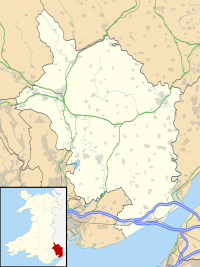Raglan Castle
| Raglan Castle | |
|---|---|
| Monmouthshire, Wales | |

The front of Raglan Castle, showing the main gatehouse
|
|
| Coordinates | 51°46′13″N 2°51′08″W / 51.7703°N 2.8521°WCoordinates: 51°46′13″N 2°51′08″W / 51.7703°N 2.8521°W |
| Grid reference | grid reference SO413083 |
| Site information | |
| Owner | Duke of Beaufort |
| Controlled by | Cadw |
| Open to the public |
Yes |
| Condition | Ruined |
| Site history | |
| Materials | Redbrook Sandstone, Old Red Sandstone, Bath Stone |
| Battles/wars | Siege of 1646 during the English Civil War |
|
Listed Building – Grade I
|
|
Raglan Castle (Welsh: Castell Rhaglan) is a late medieval castle located just north of the village of Raglan in the county of Monmouthshire in south east Wales. The modern castle dates from between the 15th and early 17th-centuries, when the successive ruling families of the Herberts and the Somersets created a luxurious, fortified castle, complete with a large hexagonal keep, known as the Great Tower or the Yellow Tower of Gwent. Surrounded by parkland, water gardens and terraces, the castle was considered by contemporaries to be the equal of any other in England or Wales. During the English Civil War the castle was held on behalf of Charles I and was taken by Parliamentary forces in 1646. In the aftermath, the castle was slighted, or deliberately put beyond military use; after the restoration of Charles II, the Somersets declined to restore the castle. Raglan Castle became first a source of local building materials, then a romantic ruin, and is now a modern tourist attraction.
Following the Norman invasion of Wales, the area around the village of Raglan was granted to William FitzOsbern, the Earl of Hereford. Some historians, such as John Kenyon, suspect that an early motte and bailey castle may have been built on the Raglan site during this period: the location had strategic importance and archaeologists have discovered the remains of a possible bailey ditch on the site. The local manor was held by the Bloet family from the late 12th century until the late 14th century, and the family built a manor house somewhere on the site during this period, surrounded by a park. By the late medieval period the Raglan site was surrounded by the large deer parks of Home Park and Red Deer Park, the latter being enclosed at the end of the period.
...
Wikipedia

